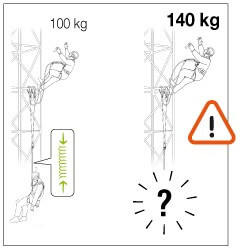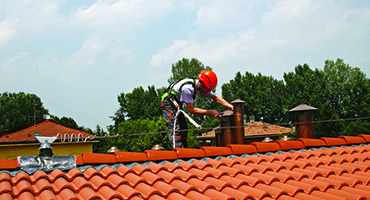Body weight requirements for the use of fall arrest devices.
Fall arrest devices: weight limits for working safely
In order to work at height, it is compulsory to be trained on Category III PPE and to use suitable fall arrest devices, as required by Standards.
However, once these requirements are fulfilled, sometimes the workers are allowed to act without considering other important aspects.
An important factor, neglected by the employer as well as by the employee themself, is the body weight of the operator who performs the activity at height. This factor impacts on safety in the activity carried out.
The Personal Protective Equipment EU Regulation 2016/425 certifies the fall protection device up to 100 kg body weight.
What if the operator's body weight who’s using the harness exceeds the 100 kg foreseen?
Especially among men, it is easy to reach or exceed such weight considering that the average height of people has increased significantly in recent years.
That's quite dangerous and not safe: in case of falling, the worker could injure himself and risk his life as the PPE equipment could break after the spreading of a higher energy than the one tested during certification. That will cause the fall in the void even if the current regulation has been followed.
How to deal with it?
It’s essential to develop a profitable collaboration with the competent doctor and HSE Manager. In case of inexperience, it is helpful to rely on qualified experts such as Sicurpal and Sicurform in order to analyze correctly the activity which has to be carried out.
In order to investigate the peculiarities of working at height with personnel whose weight exceeds the maximum load allowed for the fall arrest devices, it is necessary to carry out appropriate checks that include the identification of the physical characteristics in accordance with the devices used such as: weight, blood circulation, musculature and body, physical resistance, etc.
Any possible solutions?
It is possible to find the PPE certificate for body weight up to 120-140 kg (in accordance with US Standards ANSI/ASPP) or to check all the devices’ data sheets one by one. In any case, the risks that the worker could face during activities must be diligently evaluated, such as:
- Prohibition of moving with equipment at height: it will increase the overall weight;
- Avoid fall hazard areas: e.g., the fall may cause breakthrough;
- Work only in situations with fall factor’s a type 1 or 0 (preferably in restraint)
These requirements should be included in the working procedure, which is an important document that explains what needs to be done to perform the work safely. The work procedure should be shared with the workers, who must “prove” to have learnt all the content correctly through specific training and education.

For a 100 to 140 kg user with a lanyard longer than 1.80 m, the fall distance must be monitored or limited.
Figure - Example of a prescription inserted by the manufacturer PETZL referring to the use of a lanyard with absorber. Click here to view the full prescription.
For expert advice, PPE’s supply and anchor devices, visit www.sicurpal.en


